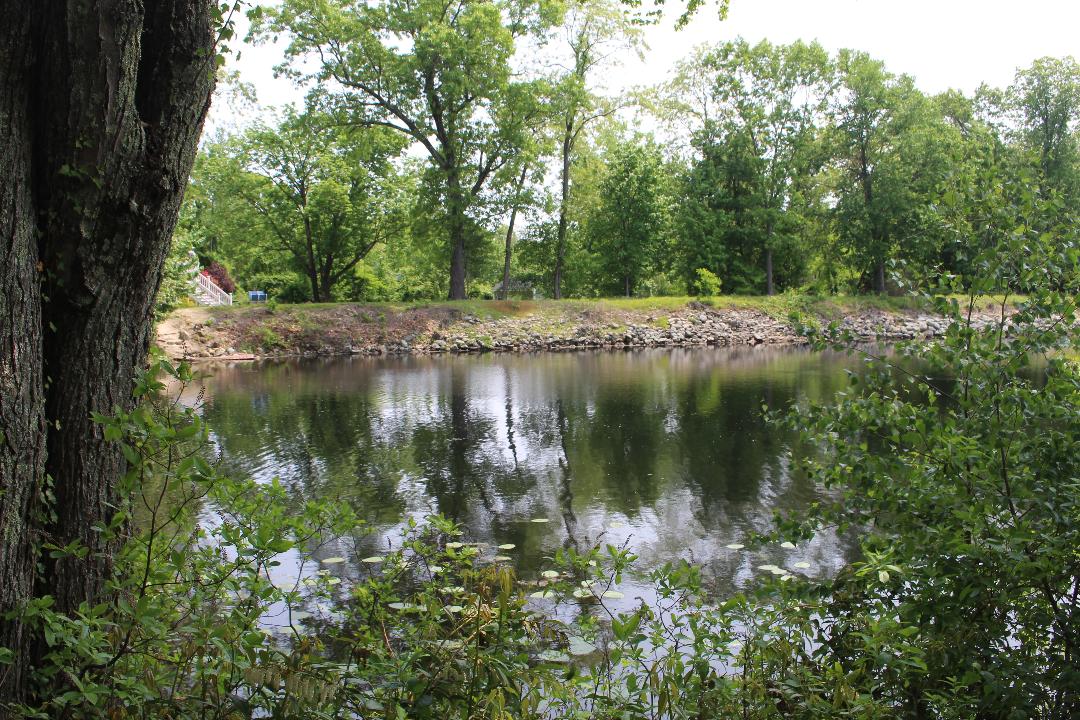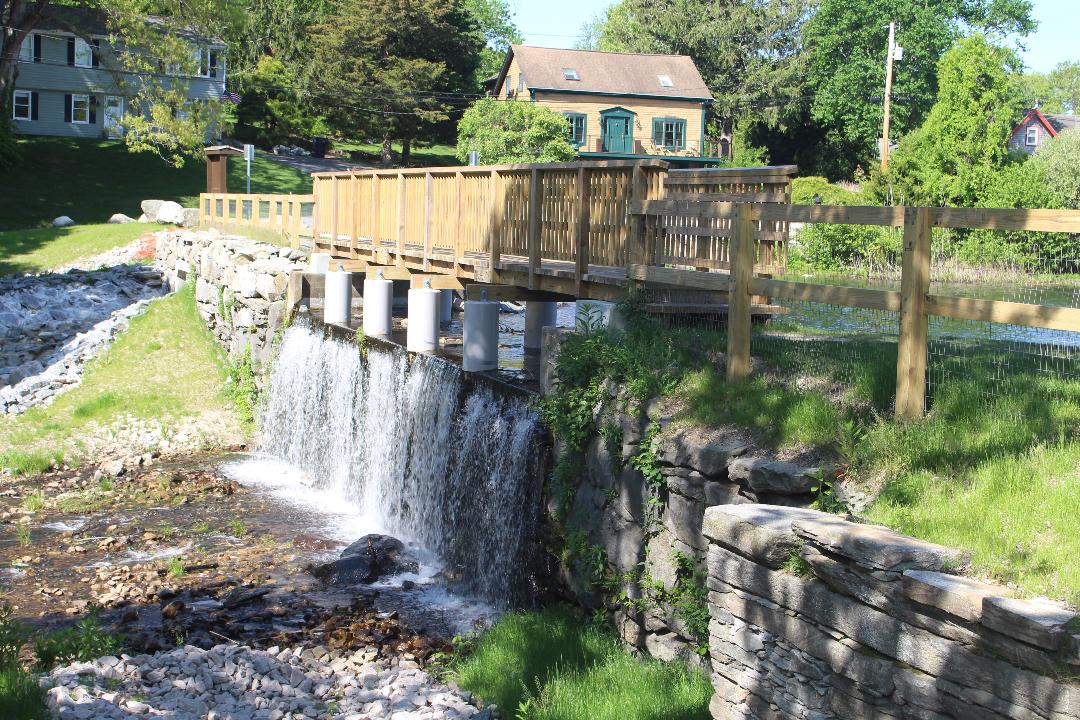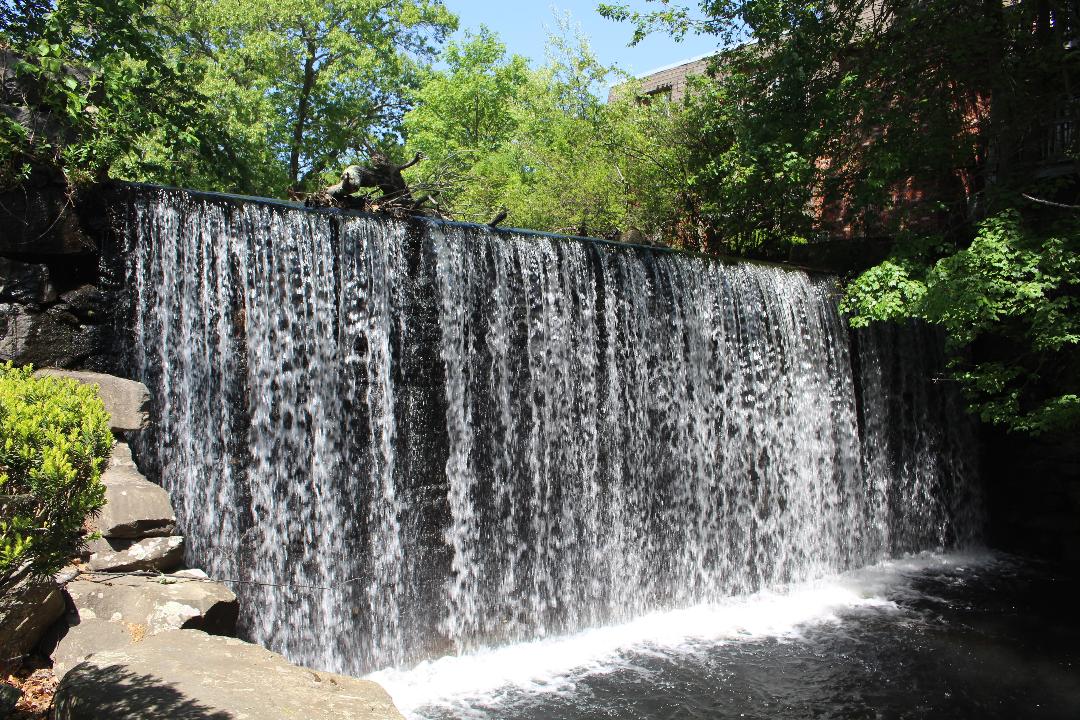DEM’s Underfunded, Understaffed Dam Safety Program Does Little to Prevent Disaster
By Colleen Cronin / ecoRI News
staff
 |
| The Almy Reservoir Dam in Johnston was marked an unsafe high-hazard dam in its most recent inspection. (Colleen Cronin/ecoRI News) |
Looking at the Almy Reservoir Dam from his lakeside property, Ken Thompson thought about all the destruction that would happen if the hulking structure — the only thing keeping the reservoir in place — gave way.
Millions of fish dead, property downstream washed away,
possibly even human lives lost if the high-hazard dam, which has been
considered unsafe for years, stopped holding up.
“It would be a big problem for people and property,” he
said.
Thompson is lucky to live above the dam, on the end of
the reservoir created out of flooded farm pasture in the 1920s. For others, the
issue hits a little bit closer to home.
Susan, who lives in the neighborhood around the dam and
asked that her last name be withheld for privacy, has had what she calls
“ponds” develop behind her house, which is adjacent to Dry Brook, a stream
connected to the reservoir. She wonders if the issue could be related to the
dam, but isn’t sure.
“I know it could be pretty catastrophic” if the dam
failed, she said.
At the end of 2021, the latest report data available
on the Rhode Island Department of Environmental Management’s website, Almy was one
of 33 unsafe high-hazard dams in the state.
Although the state knows the dams are unsafe, there isn’t
a lot that is done about it.
According to DEM’s own reports, the agency’s Dam Safety Program has
been underfunded for decades and unable to accomplish and enforce all its
mandates. The program only sees increases in funding and staffing after serious
floods or dam failures, which are rare but do happen.
‘Half a person’
There are more than 600 dams scattered
throughout Rhode Island, and although DEM doesn’t own all of them, it is
responsible for inspecting them, keeping track of their improvements, and
enforcing state laws that require dam owners to keep them in safe condition.
Most of the state’s dams are low hazard and wouldn’t
cause much damage if they failed. The types of dams that the program focuses on
are the kind that would destroy huge amounts of property (significant hazard)
or could result in death (high hazard).
The Almy Reservoir Dam in Johnston was marked an unsafe
high-hazard dam in its most recent inspection. (Colleen Cronin/ecoRI News)
Of the 173 significant-hazard and high-hazard dams, DEM
focuses most of its attention on those that are unsafe, with high-hazard dams
being the program’s “highest priority,” according to DEM.
A dam can be classified unsafe for a number of reasons
upon inspection, or because an inspection couldn’t be performed.
Vegetation was cited as the most common problem for
unsafe dams in DEM’s latest report. Vegetation either prevented an inspection
from occurring or impacted the functionality of 19 of 21 high-hazard dams with
known owners in the state.
Outlet issues were cited for 14 of those dams; 10 dams’
outlets were inoperable and four more dams’ outlets’ operationality was marked
as unknown. Ten dams also had issues with spillways.
DEM is supposed to perform a visual inspection of significant- and high-hazard dams for these safety issues every five years and two years, respectively. To meet these standards, DEM would have to inspect 48 high-hazard dams and 16 significant-hazard dams every year — but it frequently does not meet this goal.
The issue is largely staffing and funding, according to
DEM reports and Stacey Pinto, one of two environmental engineers working full
time at DEM’s Dam Safety Program.
If there was one or two more people on the team, she said
there would be a lot more the agency could do.
“I’d take anything,” she said. “I’d take a half a
person.”
Pinto became a dam inspector because of a small disaster.
Following the historic floods of 2010 and the resulting
five dam failures, she was moved from septic inspection to part-time dam
inspection.
“That was a mess,” she said.
According to DEM reports, staffing, funding, and
awareness typically only increase after something bad happens.
In January 1998, a dam failed in South Kingstown,
destroying personal property and washing away part of Route 108. The incident
sparked action. The dam inspector position at DEM, which had been vacant for two
and a half years, was filled. Editorials were written. A task force was formed
in 2001 and stricter policies were put in place.
But in every report since then, including reports
following the 2010 floods, which also drew major media attention and some increase
in staffing, DEM still states that it is understaffed.
The program currently has 2.15 staff — between two
full-time inspectors and part-time administrators — up from 1.1 in 2001.
“Taking into account the staff resources currently
available in the Dam Safety Program, the work is prioritized and not all of the
aspects of the program are completed at the frequency outlined in the
regulations,” according to the program’s most recent report.
A version of this statement is written in every report
going back to 2001.
Costly repairs
On top of a lack of staff for inspections, there is
little money for owners to complete the often very costly repairs to make dams
safe.
Some dams are state owned — by DEM or the Department of
Transportation — others are owned by municipalities and water supply companies,
private individuals, and some don’t have owners at all.
DEM has the most control over its own dams.
 |
| The Silver Spring Lake Dam in South Kingstown was recently repaired using a patchwork of funds. (Colleen Cronin/ecoRI News) |
In the past few years, DEM has been working to fix its
own high-hazard dams. Since the last safety report, many have been repaired,
such as Silver Spring Lake Dam in South Kingstown, through various funding
schemes.
Pinto pointed to different repairs on the embankment and
spillway of the dam: new riprap to prevent erosion and large rocks placed below
the dam that would slow any major influx of water from the structure itself or
runoff from a heavy storm.
The repairs cost $1.4 million, according to DEM chief of
planning and development Megan DiPrete. Federal grant money, state bond money,
and Rhode Island Capital (RICAP) funds financed the project.
Grants take time to apply for and aren’t always enough to
finance an entire project. The federal grant was $114,943, a little more than
8% of the overall cost of the repairs.
Although legislation has enabled individuals to apply for
funding through the Rhode Island Infrastructure Bank, the relative burden is
even higher for them.
DEM has on many occasions fought for years with owners
over unaddressed, unsafe conditions.
The Almy Dam in Johnston is owned by the town, according
to DEM. The agency deems the dam high hazard because of the highly populated
area it would affect if it failed.
Almy Dam is marked unsafe in its most recent safety
report because vegetation prevented an inspection, the low-level outlet was
“inoperable,” and the spillway wasn’t functioning properly.
Years of reports show DEM’s efforts to get the town to
complete repairs: issuing a notice of violation in 2010 and entering a consent
agreement in 2013, for which deadlines have since passed.
The most challenging dams to repair are the ones without
owners. DEM listed 12 unsafe high-hazard dams without owners in its last
report, two of which are considered orphan dams that through title search are
found to legally not have an owner.
The Grist Mill Dam in Warwick is one of these orphaned
structures.
Title records show reference to the dam as early as 1871.
It’s a stone dam that once powered a mill and now sits among apartments named
after it.
Pinto pointed to vegetation along the embankment, water
where it should not have been coming from, and debris blocking some flow into
the spillway. It’s categorized as unsafe but without anyone responsible to make
repairs.
Pinto said as a last resort DEM will reach out to
abutters in these instances and see if anyone would be willing to contribute to
repairs.
According to the 2021 dam report, DEM reached out to
Warwick, which has not “expressed any interest and the dam remains
unmaintained.”
 |
| The Grist Mill Dam in Warwick is considered an orphan structure. (Colleen Cronin/ecoRI News) |
It would be difficult for DEM to pay for repairs itself —
taking care of its own dams is expensive enough.
“We don’t have the funds for repairs,” Pinto said. “We
don’t have any money.”
Pinto said more and more dams will become high hazard as
development increases and more people move into areas that are in dams’ flood
zones.
The process is called hazard creep, and the reclassification
of lower hazard dams to meet their actual potential danger will be another
drain on the program without more help.
Some legislation has been passed to try to make the
state’s dams safer.
Last year two dam-related bills were signed into law. One
requires that the Building Code Standards Committee consider
the impact climate change and more intense storms will have on dam inundation
zones. The other will create an emergency notification system for dams and
allow DEM to assess fines for municipalities that don’t create emergency action
plans for their dams.
A third bill that didn’t pass would have created a fund
to repair or remove unsafe high-hazard dams that didn’t have a known owner or
had owners that couldn’t afford the costs.
“I just want people to be more aware that, you know, we
have these features out there,” Pinto said. “They’re beautiful. But they can
also be dangerous, I want people to enjoy them. But I also want people to be
safe around them.”